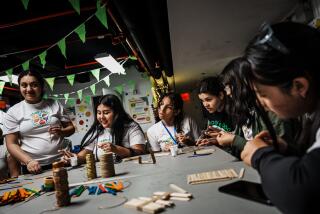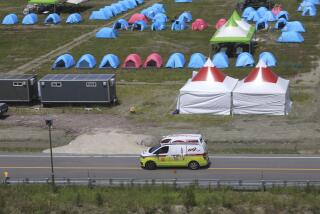500 Local Boy Scouts Will Re-Enact Events of Historic Jamboree : Reprising ’53 Revelry
- Share via
NEWPORT BEACH — Before there was a Fashion Island, before Newport Center’s high-rises scraped the sky, before condominiums were erected atop Big Canyon and before Corona del Mar High School opened its classrooms, there were Boy Scouts.
Back then, when the land east of Newport Bay was a vast expanse of dry grass, nearly 50,000 Boy Scouts from all over the world flocked to the site for a massive Jamboree that eventually lent its name to one of the main roads through town.
This weekend, 500 local Scouts will relive that historic event as they pitch their tents on one of the city’s last remaining parcels of undeveloped land in an annual ritual of campfires, competition and camaraderie.
“One of the biggest things that Scouting has is tradition,” explained Don Webb, who attended the 1953 extravaganza and is helping plan this year’s re-enactment.
“The older Scouts like me have a lot of memories. By trying to pass some of these memories and stories on to the younger kids, maybe they’ll want to pass the stories on to their kids. It’s all part of carrying the Scouting tradition forward.”
Though this weekend’s event is a fraction of the size--as a district Camporee, it includes only troops from Costa Mesa, Irvine and Newport Beach, while the 1953 gala drew Scouts from across the nation and at least 20 foreign countries--the program will mimic that of 40 years ago.
Ashes from the 1953 campfire will be sprinkled on the ground before the 1993 flames are lit. Camp will open with a film of the historic third National Boy Scout Jamboree. Commemorative patches from the two gatherings bear the same picture.
And when they encircle the bonfire Saturday night, current Scouts will borrow their predecessors’ songbook with tunes such as “Scouting Marches On,” “I’m Happy to be Hiking” and the special ditty written for the 1953 Jamboree:
There’ll be long and dusty trails,
There’ll be good tall tales
Of how we got to California
... We’ll meet Scouts from everywhere,
We’ll make friends and fill the air
With Scouting songs in California.
“It’s bringing us back into a part of history,” said Boy Scout program chairman Tim Richey, who at age 9 was too young to participate in the 1953 Jamboree but remembers visiting the sprawling campsite during the day. “We wanted to re-create it exactly.”
Well, not exactly.
Touted in the newspaper as “the greatest assemblage of democratic youth in history,” the 1953 Jamboree drew scores of celebrities from Hollywood including Bob Hope, Roy Rogers, Mitzi Gaynor, Jimmy Stewart and Debbie Reynolds. Even then-Vice President Richard Nixon stopped by to offer greetings, and the event was forever etched in local history when the thoroughfare from the freeway to the coast was renamed Jamboree Road at the conclave’s close.
With a resident population of only about 15,000, Newport Beach was overwhelmed by the enormous gathering. Laid out as a miniature United States, “Jamboree City” was set up on 3,000 acres of the Irvine Ranch, complete with its own water, electric and phone systems, and an emergency crew of four fire companies, 12 ambulances, 164 doctors and 150 police officers.
“They said it was going to be a big deal, and then when we went down there, my gosh, you wouldn’t believe how many people were down there,” recalled Jim McIlwain of Mission Viejo, who went to the Jamboree with his Anaheim troop. “It was just huge. All of a sudden overnight there was a huge community down there.”
More than 25,000 tents sprawled across the hills. Eight miles of road snaked through the camp, which was split into 34 sections.
Each troop built a gateway to mark its territory with a local icon. Boys from Orange County slept under a massive half-orange, recalled Bob Walker, who grew up in Buena Park. Lone Star flags marked the Texas turf. Philadelphians brought a replica of the Liberty Bell.
Food--52,000 eggs, 25 miles worth of hot dogs, more than 620,000 quarts of milk and 169,000 loaves of bread--was chugged in on 90 freight cars, and an additional 10 freight cars full of charcoal followed.
“It was kind of awe-inspiring,” said Karl Hufbauer, then a Scout from La Jolla, now chair of the history department at UC Irvine. “I don’t think I’ve ever seen so many kids roughly the same age in one place at one time.”
Most Scouts came by train or bus, though one troop hiked 80 miles to be there. After setting up camp, the boys explored Southern California with field trips to Santa Catalina Island, Knott’s Berry Farm and various military bases.
Many had never before seen the Pacific Ocean.
Each evening during the weeklong Jamboree, the throng converged on a massive amphitheater, one night watching a pageant about the Old West, another being entertained by film and stage stars. With the theme “Forward Together on Liberty’s Team,” the Jamboree was a symbol of international friendship among Western nations during the Cold War era.
“Japan walks arm and arm with America. Canada jokes with Australia. Denmark swims with Mexico,” observed the Los Angeles Times. “This is the opportunity for the youths of the world to meet and become friends.”
For the Scouts, the highlight of the Jamboree was not on the schedule. Trading, a time-honored tradition among Boy Scouts, flourished among the troops.
“The swap tents, in general, were as noisy and as busy as the Stock Exchange--and as representative of free enterprise,” reported The Times, noting that one boy bartered with a genuine piece of Alcatraz Island, another brought a bicycle to hawk and a third sold rides on his pogo stick for a penny.
Boys from Maine swapped lobster claws for Texas toads. Louisianians offered cotton. The local boys--who had the advantage of being able to go home to collect more loot each night--offered abalone shells and other bits of the Southern California landscape.
“Everybody wanted something from someone else,” McIlwain remembered.
Walker, who as chef for the leaders at this weekend’s Camporee will duplicate the menu of a previous generation, said his troop and some Mississippi Scouts traded a California state flag for the stars and bars.
“They told us the history of the Rebel flag and we told them the history of the California flag and the trumpets blew and the flags were raised,” Walker recalled. “As we marched out, the boys from the South would stand up and salute.”
Memorabilia from the 1953 Jamboree will be on display and for sale at the upcoming Camporee, and old-timers will be around to share their stories. Perhaps the most moving memories are of the Jamboree’s closing ceremony, when all the Scouts and thousands of guests sat on the bluffs of the bay, each holding a candle, and said goodby.
“You’ve got all these little lights, each one of them attached to an individual and all of them are Scouts,” said a wistful Webb, who came to the Jamboree by bus from Tucson, and now works for the city of Newport Beach.
“All of us were sitting there and we knew we’d never be together again,” Webb said. “We’d made friends. When the light went out, you could take the candle home and remember that you were part of that lighted arena.”
Almost Out of Site As local Boy Scouts gather this weekend for their annual Camporee, they will try to relive the historic 1953 Boy Scout Jamboree that brought nearly 50,000 campers from all over the globe to Newport Beach. This year, however, the Scouts will set up their tents on one of the last underdeveloped parcels of land in the city.
More to Read
Sign up for Essential California
The most important California stories and recommendations in your inbox every morning.
You may occasionally receive promotional content from the Los Angeles Times.










